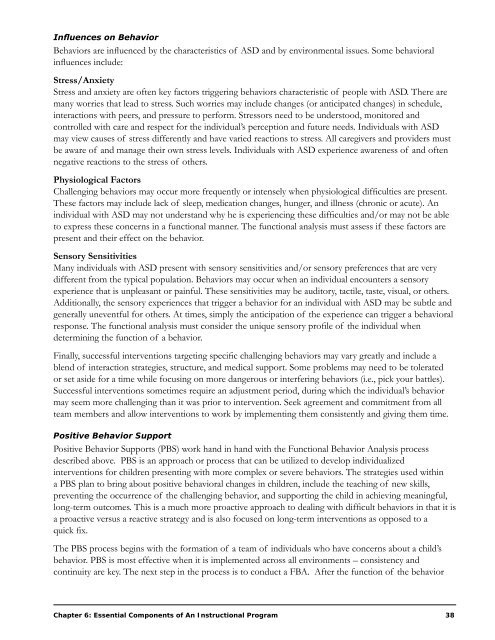Autism Guidebook for Washington State - Health Education ...
Autism Guidebook for Washington State - Health Education ...
Autism Guidebook for Washington State - Health Education ...
Create successful ePaper yourself
Turn your PDF publications into a flip-book with our unique Google optimized e-Paper software.
Influences on Behavior<br />
Behaviors are influenced by the characteristics of ASD and by environmental issues. Some behavioral<br />
influences include:<br />
Stress/Anxiety<br />
Stress and anxiety are often key factors triggering behaviors characteristic of people with ASD. There are<br />
many worries that lead to stress. Such worries may include changes (or anticipated changes) in schedule,<br />
interactions with peers, and pressure to per<strong>for</strong>m. Stressors need to be understood, monitored and<br />
controlled with care and respect <strong>for</strong> the individual’s perception and future needs. Individuals with ASD<br />
may view causes of stress differently and have varied reactions to stress. All caregivers and providers must<br />
be aware of and manage their own stress levels. Individuals with ASD experience awareness of and often<br />
negative reactions to the stress of others.<br />
Physiological Factors<br />
Challenging behaviors may occur more frequently or intensely when physiological difficulties are present.<br />
These factors may include lack of sleep, medication changes, hunger, and illness (chronic or acute). An<br />
individual with ASD may not understand why he is experiencing these difficulties and/or may not be able<br />
to express these concerns in a functional manner. The functional analysis must assess if these factors are<br />
present and their effect on the behavior.<br />
Sensory Sensitivities<br />
Many individuals with ASD present with sensory sensitivities and/or sensory preferences that are very<br />
different from the typical population. Behaviors may occur when an individual encounters a sensory<br />
experience that is unpleasant or painful. These sensitivities may be auditory, tactile, taste, visual, or others.<br />
Additionally, the sensory experiences that trigger a behavior <strong>for</strong> an individual with ASD may be subtle and<br />
generally uneventful <strong>for</strong> others. At times, simply the anticipation of the experience can trigger a behavioral<br />
response. The functional analysis must consider the unique sensory profile of the individual when<br />
determining the function of a behavior.<br />
Finally, successful interventions targeting specific challenging behaviors may vary greatly and include a<br />
blend of interaction strategies, structure, and medical support. Some problems may need to be tolerated<br />
or set aside <strong>for</strong> a time while focusing on more dangerous or interfering behaviors (i.e., pick your battles).<br />
Successful interventions sometimes require an adjustment period, during which the individual’s behavior<br />
may seem more challenging than it was prior to intervention. Seek agreement and commitment from all<br />
team members and allow interventions to work by implementing them consistently and giving them time.<br />
Positive Behavior Support<br />
Positive Behavior Supports (PBS) work hand in hand with the Functional Behavior Analysis process<br />
described above. PBS is an approach or process that can be utilized to develop individualized<br />
interventions <strong>for</strong> children presenting with more complex or severe behaviors. The strategies used within<br />
a PBS plan to bring about positive behavioral changes in children, include the teaching of new skills,<br />
preventing the occurrence of the challenging behavior, and supporting the child in achieving meaningful,<br />
long-term outcomes. This is a much more proactive approach to dealing with difficult behaviors in that it is<br />
a proactive versus a reactive strategy and is also focused on long-term interventions as opposed to a<br />
quick fix.<br />
The PBS process begins with the <strong>for</strong>mation of a team of individuals who have concerns about a child’s<br />
behavior. PBS is most effective when it is implemented across all environments – consistency and<br />
continuity are key. The next step in the process is to conduct a FBA. After the function of the behavior<br />
Chapter 6: Essential Components of An Instructional Program 38
















